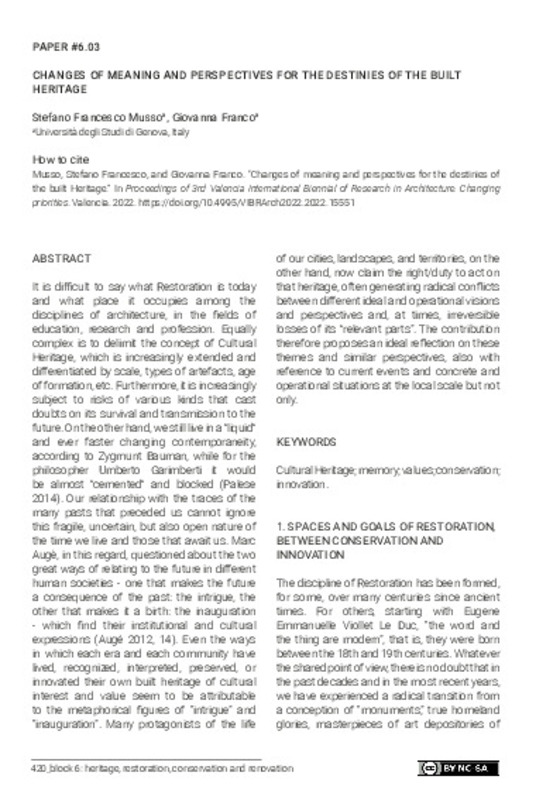JavaScript is disabled for your browser. Some features of this site may not work without it.
Buscar en RiuNet
Listar
Mi cuenta
Estadísticas
Ayuda RiuNet
Admin. UPV
Changes of meaning and perspectives for the destinies of the built Heritage
Mostrar el registro sencillo del ítem
Ficheros en el ítem
| dc.contributor.author | Musso, Stefano
|
es_ES |
| dc.contributor.author | Franco, Giovanna
|
es_ES |
| dc.date.accessioned | 2023-12-21T11:56:25Z | |
| dc.date.available | 2023-12-21T11:56:25Z | |
| dc.date.issued | 2023-05-22 | |
| dc.identifier.isbn | 9788413960265 | |
| dc.identifier.uri | http://hdl.handle.net/10251/201013 | |
| dc.description.abstract | [EN] It is difficult to say what Restoration is today and what place it occupies among the disciplines of architecture, in the fields of education, research and profession. Equally complex is to delimit the concept of Cultural Heritage, which is increasingly extended and differentiated by scale, types of artefacts, age of formation, etc. Furthermore, it is increasingly subject to risks of various kinds that cast doubts on its survival and transmission to the future. On the other hand, we still live in a "liquid" and ever faster changing contemporaneity, according to Zygmunt Bauman, while for the philosopher Umberto Garimberti it would be almost "cemented" and blocked (Palese 2014). Our relationship with the traces of the many pasts that preceded us cannot ignore this fragile, uncertain, but also open nature of the time we live and those that await us. Marc Augè, in this regard, questioned about the two great ways of relating to the future in different human societies - one that makes the future a consequence of the past: the intrigue, the other that makes it a birth: the inauguration - which find their institutional and cultural expressions (Augé 2012, 14). Even the ways in which each era and each community have lived, recognized, interpreted, preserved, or innovated their own built heritage of cultural interest and value seem to be attributable to the metaphorical figures of “intrigue” and “inauguration”. Many protagonists of the life of our cities, landscapes, and territories, on the other hand, now claim the right/duty to act on that heritage, often generating radical conflicts between different ideal and operational visions and perspectives and, at times, irreversible losses of its "relevant parts”. The contribution therefore proposes an ideal reflection on these themes and similar perspectives, also with reference to current events and concrete and operational situations at the local scale but not only. | es_ES |
| dc.format.extent | 10 | es_ES |
| dc.language | Español | es_ES |
| dc.publisher | Editorial Universitat Politècnica de València | es_ES |
| dc.relation.ispartof | Proceedings - 3rd Valencia International Biennial of Research in Architecture, VIBRArch | |
| dc.rights | Reconocimiento - No comercial - Compartir igual (by-nc-sa) | es_ES |
| dc.subject | Cultural Heritage | es_ES |
| dc.subject | Memory | es_ES |
| dc.subject | Values | es_ES |
| dc.subject | Conservation | es_ES |
| dc.subject | Innovation | es_ES |
| dc.title | Changes of meaning and perspectives for the destinies of the built Heritage | es_ES |
| dc.type | Capítulo de libro | es_ES |
| dc.type | Comunicación en congreso | es_ES |
| dc.identifier.doi | 10.4995/VIBRArch2022.2022.15551 | |
| dc.rights.accessRights | Abierto | es_ES |
| dc.description.bibliographicCitation | Musso, S.; Franco, G. (2023). Changes of meaning and perspectives for the destinies of the built Heritage. Editorial Universitat Politècnica de València. 420-429. https://doi.org/10.4995/VIBRArch2022.2022.15551 | es_ES |
| dc.description.accrualMethod | OCS | es_ES |
| dc.relation.conferencename | 3rd Valencia International Biennial of Research in Architecture, VIBRArch | es_ES |
| dc.relation.conferencedate | Noviembre 09-11, 2022 | es_ES |
| dc.relation.conferenceplace | Valencia, España | es_ES |
| dc.relation.publisherversion | http://ocs.editorial.upv.es/index.php/VIBRArch/VIBRArch2022/paper/view/15551 | es_ES |
| dc.description.upvformatpinicio | 420 | es_ES |
| dc.description.upvformatpfin | 429 | es_ES |
| dc.type.version | info:eu-repo/semantics/publishedVersion | es_ES |
| dc.relation.pasarela | OCS\15551 | es_ES |








